One of the most common genetic disruptions to blood flow in the human body that exists, sickle cell disease afflicts millions of men, women and children around the globe — up to 100,000 of them living in the United States. Yet a universal cure, or even slate of treatments to effectively combat its often painful and debilitating, at times fatal symptoms remain elusive. That could finally be about to change substantively. Following is the first in a three-part series of stories that explores this prospect among a community still languishing so far beneath the radar of public consciousness.
In a world far closer to earthly perfection than what now exists, a husband and wife wouldn’t awake one frigid winter Sunday morning to find their doe-eyed, rambunctious 5-year-old still nestled where he had slipped into bed between them during the night. Yet lifeless.
A trio of outgoing young women, two friends since childhood, wouldn’t be brought together on an appointed Saturday afternoon every summer by their mutual life of illness, pain, stigma and frustration.
A husband wouldn’t have to cradle the college sweetheart who became his wife in his arms as she takes her last breaths of life. A life, bear in mind, spent 36 years in a body too compromised by sickness to, at one time, deliver alive the twins she had yearned to leave with her husband as a legacy of their love.
In a much better world, a stoic 7-year-old who lost her spleen and gall bladder at 4 wouldn’t need monthly blood transfusions to prolong the life she had with her family among the bucolic Colorado communities bordering the Rocky Mountains. While a violin prodigy just four months her senior endures his own life-sustaining transfusions in a mountain-outlying city of the Carolinas. Having regained the ability robbed by three strokes in two years to play the instrument he first picked up at age 2, his parents now grapple to raise money for the bone marrow transplant they’re convinced will cure him.
Indeed, this present world is full of such suffering from the hereditary blood disorder that is sickle cell disease. And contrary to the overwhelming fallacy that this suffering is just a potential hazard of being black, the estimated 25 million people who populate the planet living with sickle cell disease come in an array of races and ethnicities.
A spectrum that only reinforces the reality that this disease has become a global health challenge that’s mounting, experts say.
The worldwide burden of sickle cell disease is, in fact, “set to rise as a consequence of improved survival in high-prevalence, low- and middle-income countries, and population migration to higher-income countries,” explains Frédéric B. Piel, a lecturer in the Imperial College London’s department of epidemiology and biostatistics.
“In high-income countries,” he elaborates, “the costs of care and hospitalization are high, particularly when early diagnosis doesn’t allow preventing some complications.”
“In low- and middle-income countries, substantial improvements to reduce childhood mortality means that affected children who would have previously died undiagnosed can now survive,” Piel continues. “And require either specific care to prevent later complications, or adequate services to manage present and future complications. Overall, the number of patients is increasing in both groups of countries, which is likely to lead to growing demands on healthcare services.”
People with sickle cell disease are born with abnormal hemoglobin, the protein in red blood cells that carries oxygen from the lungs throughout the body, and returns carbon dioxide from the ubiquitous network of tissues composing the body to the lungs. Inheriting one aberrant hemoglobin gene from each of their respective parents, these individuals live with red blood cells that don’t always remain typically round and pliable for easy travel through the body’s small and large blood vessels. Instead, the cells elongate at times into rigid, sickled (or crescent) shapes that clump together and get stuck in the smallest vessels.
This sudden obstruction of oxygen not only causes red blood cells to die off months earlier than normal, rendering someone with sickle cell disease vulnerable to anemia and infections. It can also trigger severe episodes of pain known as sickle cell, or vaso-occlusive crises at any given moment in that person’s arms, legs, chest, stomach, lower back, and joints and bones. Plus, lead to other complications like jaundice, leg ulcers, organ damage and even strokes.
Three quarters of sickle cell cases are reported in Africa, devastating the continent’s sub-Saharan nations in particular, according to the World Health Organization. And while all babies born in the United States are screened for sickle cell disease, the most likely to test positive for this nation’s most common inherited blood disorder are, in fact, black newborns. About one in every 300 to 500 of these fledgling souls.
Faces of the sickle cell community
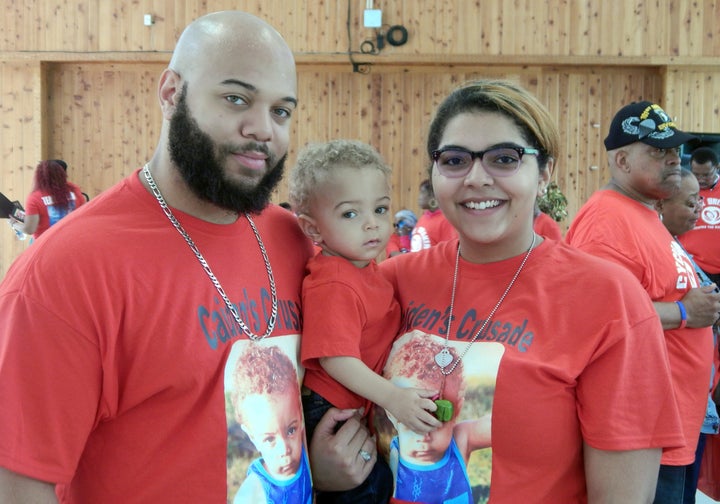
Caiden, who was born with sickle cell disease, with his parents.
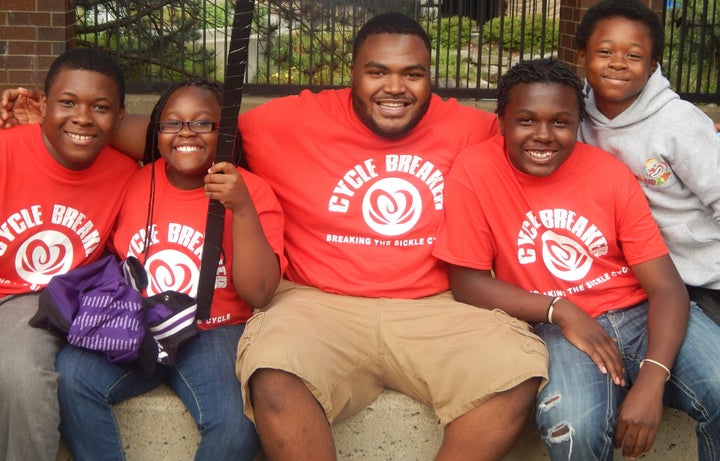
Five of the seven Johnson siblings, two of whom, Donald and Daunte, have sickle cell disease. Their sister, Paris, carries the genetic trait.
In contrast, among Hispanics of Caribbean ancestry, the second largest group in the U.S. affected by sickle cell disease, one in every 1,000 to 1,400 babies is born with it, according to data compiled by the U.S. Department of Health and Human Services. One in every 3,000 Native American babies is born with the disease. While only about one in every 60,000 white babies is born in this country with sickle cell disease.
Yet the people who are afflicted with this blood-flow anomaly throughout the Middle East, India, Sri Lanka and Nepal underscore a far more encompassing reality. It is that sickle cell disease, present among the Mediterranean populations of southern Europe, and in Central and South America as well, is among the most widespread life-curtailing, inborn conditions afflicting humanity.
Burdening not only the individuals who suffer directly from living with this inherited disorder, points out Dr. Grace Onimoe, a pediatric hematologist with the Cleveland Clinic Children's hospital. But the families and entire communities also confronted with the physical, psycho-social and economic toll of their illness.
"Sickle cell disease is a global disease," Onimoe maintains of a genetic disorder that the United Nations first designated for global recognition every June 19 (Juneteenth, the oldest known commemoration of slavery's legal end in the U.S.) eight years ago.
Sickle cell disease plagues more people worldwide, in fact, than such genetic ailments far more familiar to the public as hemophilia and cystic fibrosis.
"It is estimated that more than 300,000 babies are born each year with sickle cell disease, that is, more than 1,000 babies every day," says Dr. Isaac Odame, medical director of the Global Sickle Cell Disease Network.
Adds the physician in the hematology/oncology division as well of Toronto's Hospital for Sick Children, "[And] this is only an estimate, as there are very few countries that have programs for universal testing of newborns to provide accurate numbers."
Compare that, nonetheless, with about one in every 3,000 babies annually said to be born worldwide with cystic fibrosis. That's about 43,300 of the 130 million babies tallied by UNICEF to come into the world year after year.
“There are multiple companies working to develop medicines, particularly to actually decrease the pain and sickling problem.”
—Dr. Susumu Inoue
It is the ever-dawning realization of just how prevalent and formidable sickle cell disease is — slated to plague more than 400,000 newborns a year globally by 2050 — that seems to be helping to drive the burgeoning pharmaceutical and genetic research of late in fighting it. And, in turn, optimism that a host of far better ways to manage and treat this affliction, even widely rid people of it altogether, are at hand.
All told, some $227 million has been invested in public and private companies in the U.S. since October 2011 to break new ground in treating sickle cell disease, the London-based Edison Investment Research Ltd. has estimated.
And the consequent advances that these companies are making — along with various universities, hospitals and health organizations — are on multiple wellness fronts. From developing drugs that prevent red blood cells prone to sickling from doing so, to blood tests that can help experts predict the timing and severity of symptoms among sickle cell sufferers. There are even potential therapies to literally correct the genetic glitch that causes this disease in the first place.
Currently awaiting several patent approvals is a tiny device that analyzes the unique behavior of red cells in blood samples, under manipulated oxygen conditions, from people with sickle cell disease. Developed over a 10-year period, the device is the creation of a multidisciplinary team of researchers from Carnegie Mellon University, the University of Pittsburgh Medical Center, the Massachusetts Institute of Technology, Florida Atlantic University and Brown University.
Their invention uses a technology called "microfluidics" to achieve the intricacy of screening that these researchers assert would not only help doctors more accurately predict and, ultimately, prevent pain episodes in sickle cell patients. But according to them, even help test for the effectiveness of emerging drug treatments.
"There are multiple companies working to develop medicines, particularly to actually decrease the pain and sickling problem" as well, says Dr. Susumu Inoue. Consequently, adds the pediatric hematologist/oncologist at the Hurley Medical Center in Flint, Mich., "there are at least six or seven medicines" that are currently in Phase I or II trials for potential commercial use."
"Compared to what it used to be, that is tremendous improvement," Inoue continues. Improvement in pursuing advanced sickle cell treatments that he mentions Hurley has had a hand in with its participation in several clinical trials. Including the final phase of one such trial launched back in February of an experimental drug developed by San Diego pharmaceutical company, Mast Therapeutics Inc.
Although this drug generically known as MST-188 was recently knocked out of contention in the bid to bring cutting-edge relief to people with sickle cell disease, it's still one of only a handful of such potential therapeutic interventions that has been evaluated to this extent.
And among literally thousands that Dr. Yutaka Niihara summarizes has been proposed over the years to prevent the physiological damage that this disease can wield. Most were determined to be too toxic to even get to the pre-clinical phase of testing, according to this hematologist/oncologist who co-founded the Torrance, Calif., pharmaceutical company, Emmaus Life Sciences Inc.
Of the 80 or so medications that actually made it into clinical trials, Niihara notes in an October 2012 interview with online health periodical News Medical, Emmaus Life Sciences developed one that, like Mast Therapeutics', also reached Phase III testing.
MST-188, the intravenous treatment developed by Mast Therapeutics, was actually poised to become only the second medication that actually thwarts how sickle cell disease attacks the body approved for commercial use by the U.S. Food and Drug Administration (FDA) in almost 20 years. Nearly 400 sickle cell patients, ages 4 to 46, were evaluated at more than 75 medical sites in 14 countries in the Phase III trial of MST-188 that Mast Therapeutics called EPIC (Evaluation of Purified Poloxamer 188 In Crisis).
And though EPIC's outcome proved "exceptionally disappointing and unexpected," Brian Culley, the company's chief executive officer, conceded in a Sept. 21 conference call with investors and journalists, the impact that this undertaking has had on advancing sickle cell research can't be overlooked.
"Being that it was the largest placebo-controlled clinical trial conducted to date in sickle cell disease, we believe this Phase III study will provide learning from data that will be valuable and insightful for others who will design future studies in sickle cell disease," offers Culley.
Niihara concurs. "A failed trial should only be a lesson to design a better study or search for something better," he responded to Mast Therapeutics' setback, citing that such hurdles in clinical research have, in fact, ultimately lead to breakthroughs in curing diseases.
Navdeep Singh doesn't have sickle cell disease, but looks forward to such a breakthrough with this illness, nonetheless. The 31-year-old registered nurse and newlywed has thalassemia, another hereditary blood disorder that has had him undergo a blood transfusion every month of his life since he was 9 months old.
"I have supported the sickle cell cause for a long time," says Singh, who calls thalassemia, which stifles hemoglobin production, a "cousin" to this disease. And who donated money to sickle cell causes and wore a burgundy "Awareness" bracelet for years before last summer starting what has become a commitment for this Detroiter: participating in the annual walk-a-thon hosted by the Michigan chapter of the Sickle Cell Disease Association of America.
"I support this issue because I know that my disease, thalassemia, and sickle cell are closely linked, and a cure for one would mean a cure for the other," Singh explains.
"Sickle cell disease, although seen primarily as a black concern, is still a disease process representing hemoglobin irregularities that are cross-linked with other regions," continues the recent Master of Science recipient who works in the surgical ICU at Detroit Receiving Hospital. Along with thalassemia, he notes, both diseases are "prevalent in malaria-plagued areas as an evolutionary mechanism to fight against malaria."
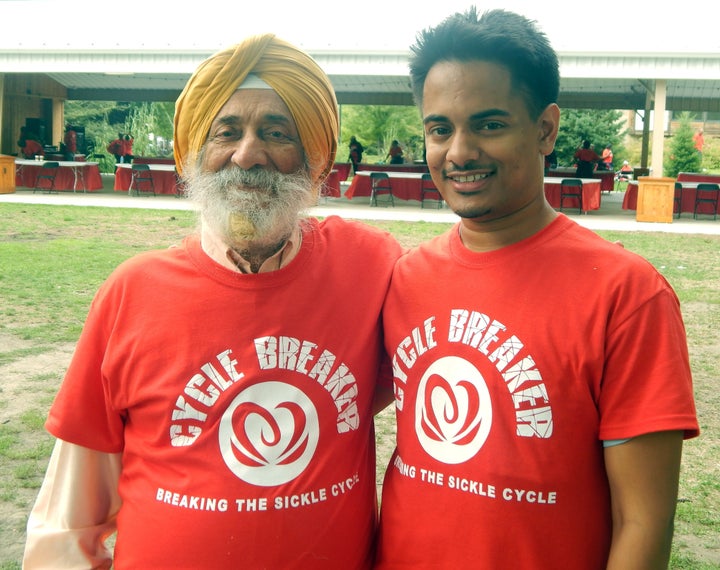
Navdeep Singh, with his father, Harpreet Singh, Ph.D. Navdeep inherited thalassemia from his parents, another hemoglobin disorder that he refers to as a "cousin" to sickle cell disease.
Indeed, Niihara corroborates, "if sickle cell disease can be cured, that will open the pathway to curing other genetic diseases." Starting with those caused by the mutation of just a single gene as well, such as cystic fibrosis, hemophilia and muscular dystrophy.
Then there's the tendency that sickled red blood cells have to not only instigate clots that obstruct the tiny capillaries sprawling throughout a person's body, damaging the ultra-thin lining of these vessels in the process, Niihara elaborates. But to prompt the tissue inflammation that comes with this sticky, hyper-coagulated blood flow as well. Finding the key to preventing all these malfunctions could, in turn, help to prevent other health consequences of circulatory breakdowns like heart attacks, abnormal heart rhythms (or arrhythmias), and strokes.
The day can't come soon enough for Inoue when there's much more available to help him and his colleagues in medicine alleviate the suffering — and fatality — that's a way of life for so many individuals with just sickle cell disease alone.
"I'd like to see medication that will increase their life spans 20 to 30 years," he says, still readily able to recall children with sickle cell disease he has cared for throughout nearly 50 years specializing in pediatric medicine. Many he has watched grow up from infancy and even socialized with, with their families, at bowling parties, high school graduations and the like; some, only to die shortly after they must leave his care as young adults. Others don't even survive childhood, like the little girl brought to the ER where he was working some 25 years ago with a raging fever late one afternoon.
Well aware that such children are at risk for severe infections, he ordered that a blood culture be drawn from the girl and antibiotics be given to her. Unfortunately, she didn't get the antibiotics until "a whole hour after she was admitted to the hospital," he shares. "In four hours the child died of overwhelming bacterial infection."
These days, kids with sickle cell disease are regularly given special vaccines, in addition to all the customary childhood ones, to inoculate them against the strep and other bacterial infections that once routinely killed them during such crises. Inoue attributes this public health strategy to not having to endure yet another young patient succumb to the sepsis that ultimately took the life of that little girl who still tinges his memory.
Still, he yearns for the time when living past the age of 80 with sickle cell disease — such as 86-year-old Ernestine Diamond of Kansas City, Mo., and 90-year-old Nigerian grandmother Asiata Onikoyi-Laguda — is no longer the rarity it is now.
"But living [longer] is not good enough," Inoue counters. "You have to have a good quality of life. That means no pain. Less organ damage. No strokes. No kidney disease and no joint problems. Those would be the days I'd like to see."
"The first and most import thing to note is that the level of advocacy is higher than it has been for the last several decades."
—Gary A. Gibson
Days, in fact, that appear to be very much on the horizon given all the money and research that has been poured into taking on sickle cell disease in recent years. Even if motivated at times more out of a quest for potential financial gain, says Inoue, than altruism.
"For many, many years until very recently, all the pharmaceutical companies have looked at sickle cell disease as an area where they cannot make any profit," he continues. "That's one reason why research has been hampered. But that has changed thanks to the grass roots efforts of patients and their supporters."
Supporters like Gary A. Gibson, president and chief executive officer of the Martin Center Sickle Cell Initiative in Indianapolis. Having lost his first wife to sickle cell disease nearly 27 years ago, he has been active ever since working to bring attention to this genetic killer through educational presentations, health fairs, social media campaigns and other outreach initiatives by the Martin Center. And busy advocating for state and federally funded research, treatment and preventive measures as well to better the lives of those with sickle cell disease.
"I am the survivor of a spouse who passed away from sickle cell after 12 years of marriage and three to four years of dating," Martin shares of the graphic designer he met while they were both still undergraduate students at Marygrove College in Detroit in the 1970s.
"She passed away Dec. 1, 1989," he continues about the evening a massive heart attack finally took her life, at 36 years old, as he held her in his arms at their home. That was after having already miscarried the couple's only children, twin girls, during another severe crisis three years earlier.
"From that time I started working as a volunteer at the Martin Center, and eventually ended up on the board of directors for about 10 years," Gibson elaborates about the impact of his wife's death.
With him now at the helm of the Martin Center full-time, the nonprofit human services agency received a grant for $143,609 from the Indiana State Department of Health for the two-year ER education program it launched last October. And, as a result, is now "reaching out to ER administrators, physicians and nurses to educate them about sickle cell treatment protocols and cultural sensitivity" through what the Martin Center is calling the Emergency Department Sickle Cell Education Project.
Such feats only further compel Gibson, who also hosts a weekly, two-hour internet radio show sponsored by Mast Therapeutics called the Sickle Cell Action Network, in working to improve the lives of those with sickle cell disease and their loved ones. That, and the inspiration still gleaned from the "amazing individual" he proclaims to this day was worth sharing a life with, despite the challenges of her illness that permeated their marriage.
"It's given me a life purpose," says Gibson of the woman who scared him off for two years with her disclosure that she had sickle cell disease when they started dating in college, but he couldn't stop thinking about all the while. "It allows me to do what I do, to speak with the passion that I speak with."
And, in turn, have a front-line grasp on the overall state of support for the sickle cell community.
"The first and most import thing to note is that the level of advocacy is higher than it has been for the last several decades," Gibson says, citing the activism of individuals and organizations on social media as a major contributor to this.
"From a legislative standpoint," he concedes, however, "there's still a lot of work to do."
Take the 2015 bill to expand Indiana's sickle cell research and services that the Martin Center worked on with state Democratic Representative Gregory Porter. Though it did end up generating an additional $290,000 in annual funding for the state's Sickle Cell Program, says Gibson, some of which is funding the Martin Center's ER program, the measure ultimately died out in the state's legislature.
Then there's the bipartisan proposal by Democratic Congressmen Danny K. Davis and his Republican counterpart out of Illinois, John Shimkus, to reauthorize the Sickle Cell Treatment Act. Signed into national law under President George W. Bush in 2003, the measure ran out of funding in 2009. And, as Gibson points out, Davis and Shimkus' bid to resuscitate it has languished in the U.S. Congress for five years.
Even more reason for the Martin Center to push forward with the mission to aid and enhance the lives of people affected by sickle cell disease that it has come to wage since first emerging as a civil rights group in 1969. And the agency — named for the Rev. Martin Luther King Jr., and 16th century lay minister to the black, impoverished and other disenfranchised communities of Peru, St. Martin de Porres — continues to have its work cut out for it.
Especially given how race, apathy, and the scarcity of both money and prominent voices of support have all, according to Gibson, factored into hindering this cause.
"It is frustrating that there are still so many people who don't know about sickle cell," he admits. "It's even more frustrating that even those who know about it don't really understand its impact on patients and their families."
An impact that's no respecter of persons, considering the various celebrities who have come to light over the years as having sickle cell disease. From as far back as Motown crooners Paul Williams of the Temptations, and Georgeanna Tillman Gordon of the Marvelettes. To iconic jazz trumpeter Miles Davis, whose drug and alcohol use to cope with the pain of this disease is said to have contributed to his infamous addictions.
Then there are the more contemporary stars like actor Larenz Tate, former New York Giants running back Tiki Barber, rapper Prodigy of Mobb Deep, and Tionne "T-Boz" Watkins of the former R&B/hip-hop girl group, TLC.
The Martin Center has held an annual, daylong conference since 2011 to confront the naiveté about sickle cell disease that abounds, nonetheless. And featured such notable figures as Craig Hooper, director of the blood disorders division under the National Center on Birth Defects and Developmental Disorders, via this forum.
Cooper gave an overview of his center's overarching Centers for Disease Control, and heard testimony from sickle cell patients and providers at a town hall meeting the day before this year's conference back in April. Dr. Wanda Whitten-Shurney was the keynote speaker at the conference.
Daughter of the late Dr. Charles Whitten, a renowned sickle cell researcher who founded the SCDAA in 1971, Whitten-Shurney is an authority in her own right. She's a 29-year pediatrician at the Sickle Cell Center in the Children's Hospital of Michigan that comprises the Detroit Medical Center. Whitten-Shurney is also chief executive and medical director of the SCDAA's Michigan chapter.
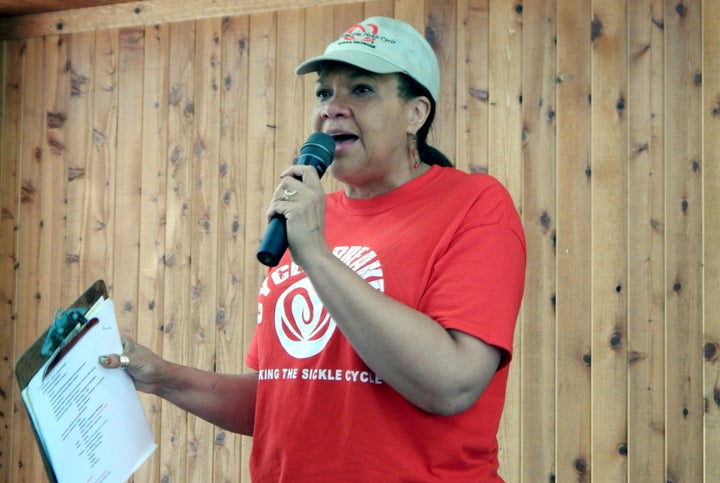
Dr. Wanda Whitten-Shurney, chief executive and medical director of the Sickle Cell Disease Association of America, Michigan Chapter.

Consoling Kimberly Foster as she grieves for her son, Dwight Foster, lost to sickle cell disease.
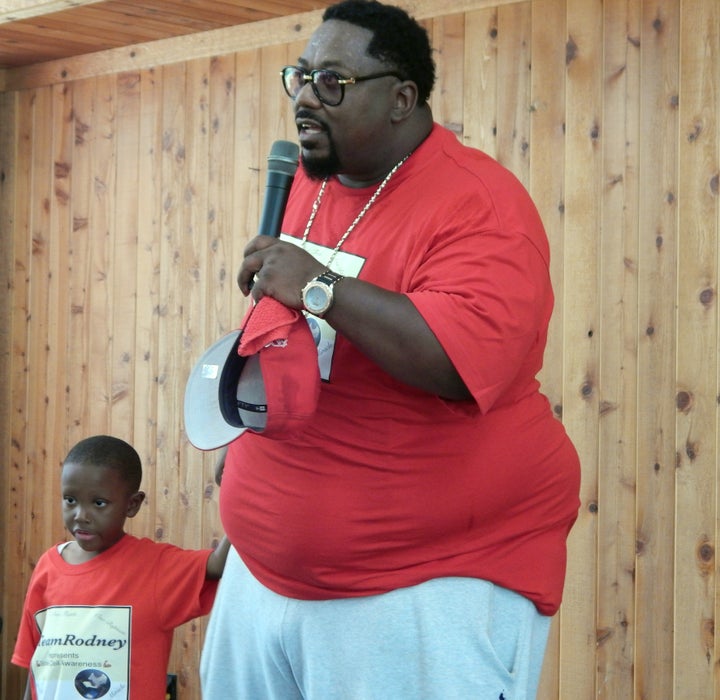
The Rev. Maurice Hardwick, pastor of Detroit's Body of Believers Outreach Ministries, leading the prayer to conclude the second annual awareness walk-a-thon hosted at the Detroit Zoo by the SCDAA's Michigan Chapter.
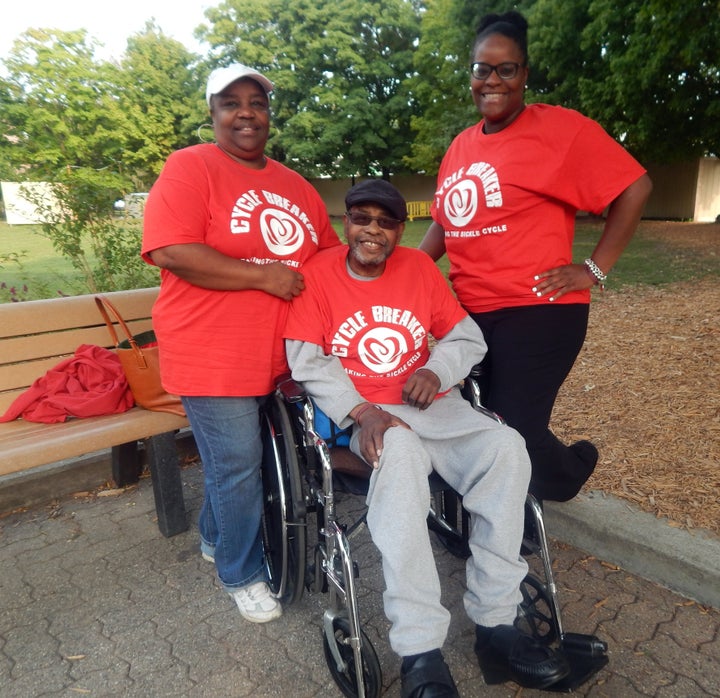
Vera and Eric Smithson with their niece, Deloris Daffin.
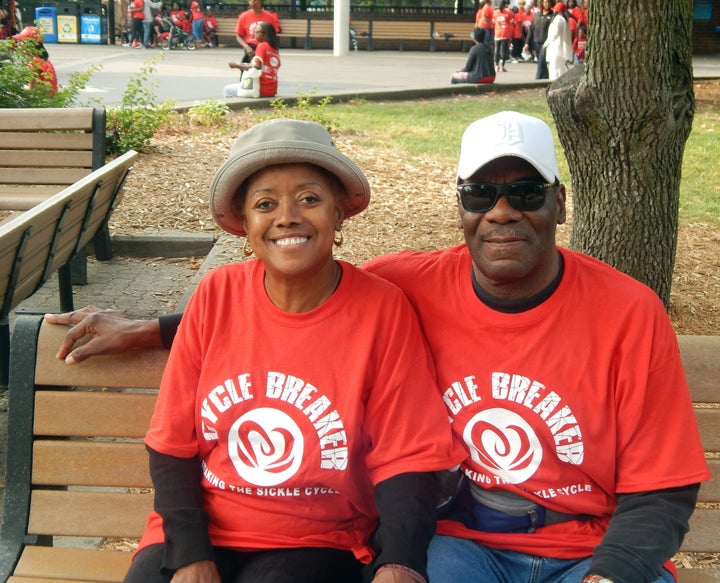
Eileen and John Brown.
Yet it is the sentiment that emerged during an exchange Gibson had several years ago that underlines the perception of sickle cell disease and need for more stringent efforts to seek its cure. While waiting in the lobby of an auto shop for his car to be repaired, Gibson struck up a conversation with an elderly African American woman.
"Sickle cell; is that still around?" he recalls of that other customer's response to what he shared that he did for a living. "I said, 'Yes ma'am, and it's still causing pain.'"
Next is an in-depth look at what exactly is on the horizon to help people with sickle cell disease get better. Go here to access all of the stories in this special series. The author, King, is herself a carrier of the trait for this disease. A Detroit-area writer, independent filmmaker and actress, she was inspired to write this series by the loss of three sons, ages 5, 31 and 50, to the genetic disorder within two years in families she knows or knows of. To learn more about King, visit A Square Peg/Round Hole Creation, LLC.
